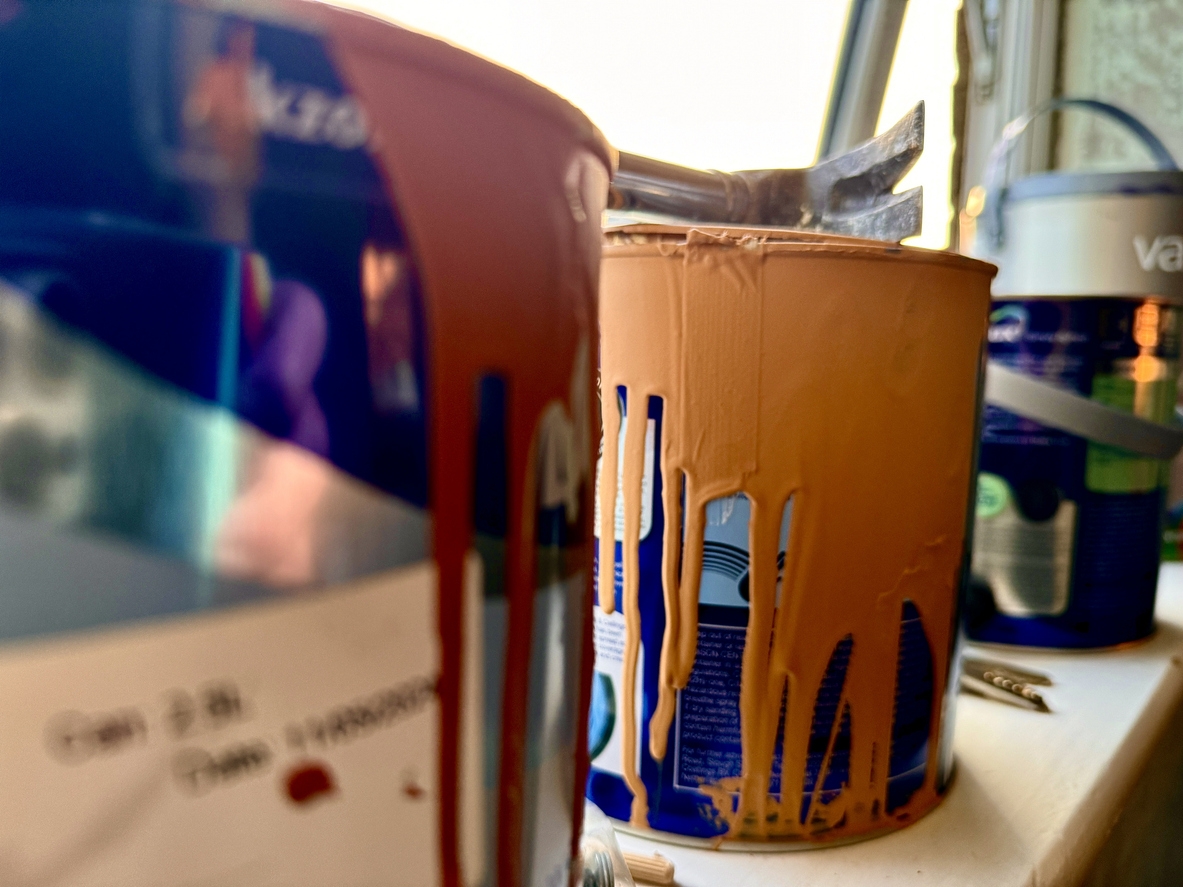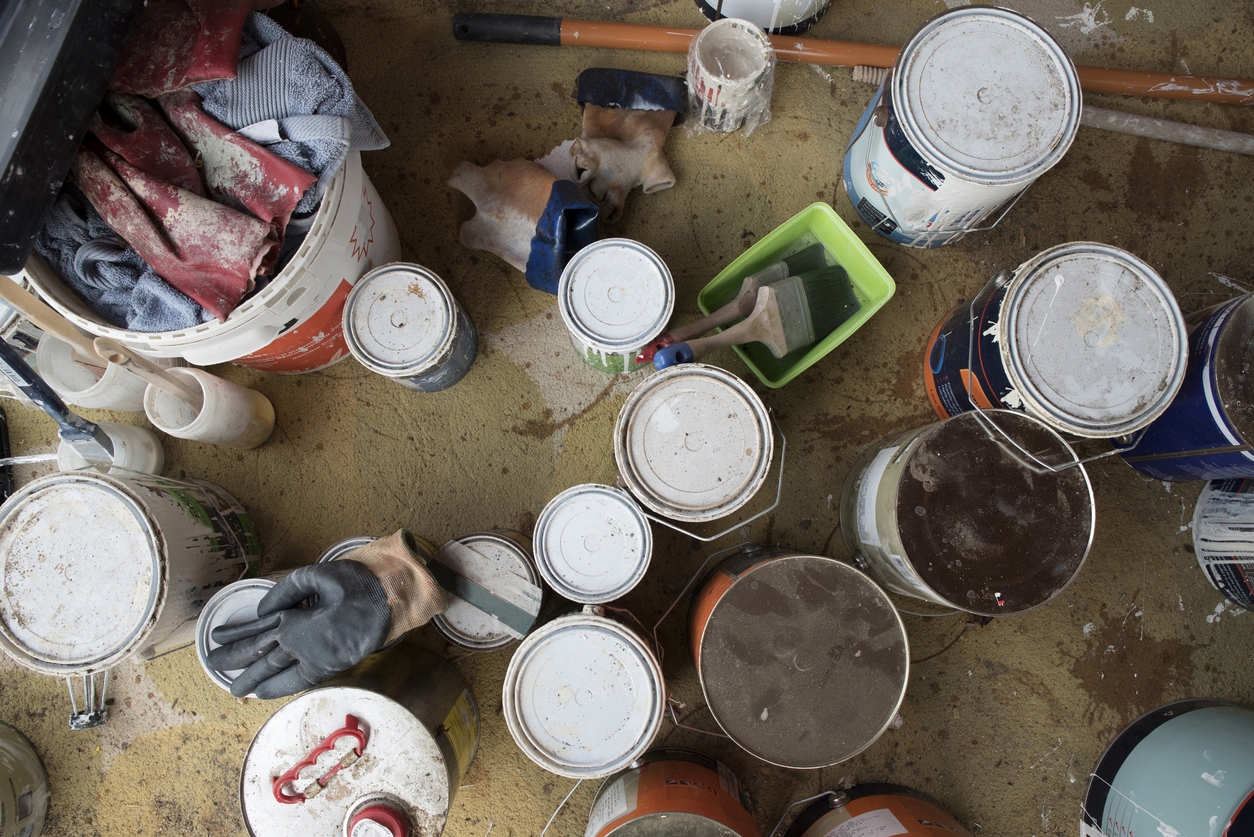Proper disposal of leftover paint is essential after completing a commercial painting project in the Danville, CA area. Not only does it help protect the environment, but it also ensures compliance with local regulations. This article will guide you through the safest methods to dispose of leftover paint, providing practical tips and highlighting the importance of responsible disposal practices.
Whether you’re a professional painter or a business owner, following these guidelines will help you manage leftover paint safely and efficiently.
Understanding Paint Types
When embarking on a painting project, it’s important to understand the differences between the types of paint available, particularly latex and oil-based paints. Each has distinct properties and specific disposal requirements that must be followed to ensure safety and environmental responsibility. There are also different types of painting projects such as commercial stenciling, faux painting, decorative painting and more that should be taken into consideration.
Differences Between Latex and Oil-Based Paints
Latex Paint (Water-Based)
- Composition: Latex paint is made with water as the primary solvent, making it less toxic and easier to clean up.
- Application: It dries quickly, usually within an hour or two, and can be cleaned up with soap and water.
- Durability: Latex paint is durable, flexible, and resistant to cracking and fading. It’s suitable for a variety of surfaces, including walls, ceilings, and trim.
- Finish: It typically has a smooth, even finish and is available in a range of sheens from flat to glossy.
- Environmental Impact: Latex paint emits fewer volatile organic compounds (VOCs) than oil-based paint, making it a more environmentally friendly option.
Oil-Based Paint
- Composition: Oil-based paint, also known as alkyd paint, uses oil or synthetic resins as the base, requiring solvents like mineral spirits or turpentine for cleanup.
- Application: It takes longer to dry, often 24 hours or more, which can be beneficial for creating a smooth, hard finish.
- Durability: Oil-based paint provides a durable, high-gloss finish that is excellent for surfaces that experience heavy wear and need frequent cleaning, such as doors, cabinets, and trim.
- Finish: Oil-based paint is known for its rich, lustrous finish, superior leveling, and less tendency to show brush strokes.
- Environmental Impact: Oil-based paint emits higher levels of VOCs, contributing to air pollution and posing health risks if not used in well-ventilated areas.
Specific Disposal Requirements for Each Type
Latex Paint Disposal
- Dry It Out: Latex paint can often be disposed of in regular household trash once it’s fully dried. Small amounts can be dried out by leaving the lid off, or by using paint hardeners, kitty litter, or shredded paper.
- Recycle: Many communities offer recycling programs for latex paint. Check with your local waste management facility for guidelines.
- Hazardous Waste Collection: If there is a large amount of leftover latex paint, it should be taken to a local hazardous waste collection site for proper disposal.
Oil-Based Paint Disposal
- Hazardous Waste: Oil-based paint is classified as hazardous waste due to its flammable nature and high VOC content. It should never be disposed of in regular trash or poured down the drain.
- Hazardous Waste Collection: Take leftover oil-based paint to a local hazardous waste collection facility. Many communities have designated days or sites for collecting hazardous materials.
- Storage: If you plan to keep leftover oil-based paint for future use, ensure it is stored in a cool, dry place, tightly sealed to prevent spills and reduce exposure to VOCs.
By understanding the differences between latex and oil-based paints and their respective disposal requirements, you can make informed decisions that contribute to a safer and more environmentally friendly painting project. Proper disposal not only protects the environment but also ensures compliance with local regulations, helping to maintain a safe community.
Immediate Steps to Take
After completing a painting project, it’s important to manage any leftover paint responsibly. Proper storage and labeling can ensure the paint remains usable for future projects and is safely contained to prevent environmental hazards. Here are the immediate steps to take:
Storing Leftover Paint Properly
1. Choose the Right Storage Location:
- Cool and Dry Place: Store paint in a cool, dry area away from direct sunlight and extreme temperatures. A basement or a utility closet is often ideal.
- Elevated Storage: Keep paint cans off the ground to prevent rusting and potential damage from moisture.
- Temperature Control: Avoid storing paint in places that experience significant temperature fluctuations, such as garages or outdoor sheds. Extreme heat can cause paint to dry out while freezing temperatures can spoil it.
2. Use Airtight Containers:
- Original Can: If the original paint can is still in good condition, it’s best to store the paint in its original container. Ensure the rim and lid are clean before sealing to achieve an airtight fit.
- Alternative Containers: If the original can is damaged, transfer the paint to a clean, airtight container made of plastic or metal. Label the new container with all relevant information.
3. Minimize Air Exposure:
- Reduce Air Space: If there’s a small amount of paint left, transfer it to a smaller container to reduce the amount of air inside. Less air exposure helps prevent the paint from drying out.
- Plastic Wrap: For added protection, place a layer of plastic wrap over the paint before sealing the can. This can help keep air out and extend the paint’s shelf life.
Labeling and Sealing Paint Cans
1. Proper Labeling:
- Paint Details: Clearly label the paint can with essential details such as the brand, color, date of purchase, and where it was used (e.g., “Living Room Walls”).
- Color Sample: Apply a small dab of the paint on the lid or side of the container for easy identification of the color without having to open the can.
- Usage Instructions: Note any specific instructions or mix ratios (for custom colors) on the label to ensure consistency in future applications.
2. Sealing Paint Cans:
- Clean the Rim: Wipe the rim of the paint can with a cloth to remove any excess paint. This helps ensure a tight seal and prevents the lid from sticking.
- Use a Rubber Mallet: Gently tap the lid back into place using a rubber mallet. Avoid using a regular hammer, which can damage the lid and create an imperfect seal.
- Check for Leaks: Once sealed, turn the can upside down for a few seconds to check for leaks. If any paint seeps out, re-secure the lid until the seal is airtight.
By storing leftover paint properly and ensuring paint cans are correctly labeled and sealed, you can extend the life of your paint, making it easier to use for touch-ups or future projects. These steps also help prevent accidental spills and reduce the risk of environmental contamination, contributing to a safer and more organized workspace for Blackhawk, CA area projects.
Disposal Methods
Disposing of leftover paint requires careful consideration to protect the environment and comply with local regulations in the Bay area including San Ramon. There are several methods available, including utilizing local hazardous waste collection programs, exploring paint recycling and donation options, and taking advantage of special disposal events and drop-off locations.
Local Hazardous Waste Collection Programs
1. Understanding the Programs:
- Municipal Services: Many local governments offer hazardous waste collection programs specifically designed to handle materials like paint. These programs ensure that hazardous substances are disposed of safely and in compliance with environmental regulations.
- Scheduled Pick-Ups: Some areas provide scheduled pick-up services for hazardous waste. Check with your local waste management department to see if this service is available in your community.
2. Drop-Off Sites:
- Designated Locations: Communities often have designated hazardous waste drop-off sites where residents can bring their leftover paint. These sites are equipped to handle the safe disposal of paint and other hazardous materials.
- Operational Hours: Be sure to check the operational hours and any specific requirements or restrictions before bringing your paint to a drop-off site.
Paint Recycling and Donation Options
1. Paint Recycling:
- Recycling Facilities: Certain recycling facilities accept leftover paint and repurpose it into new paint products. This process reduces waste and promotes the sustainable use of resources.
- Local Guidelines: Contact local recycling centers to understand their policies and procedures for accepting and processing paint.
2. Paint Donation:
- Community Organizations: Consider donating your leftover paint to community organizations, schools, theaters, or non-profit groups that may have ongoing projects and can make use of the paint.
- Habitat for Humanity: Organizations like Habitat for Humanity often accept paint donations for their building projects. Donating paint can support community development and reduce waste.
3. Paint Exchange Programs:
- Local Initiatives: Some communities offer paint exchange programs where residents can drop off unused paint and pick up paint donated by others. This is a great way to ensure that usable paint doesn’t go to waste and can benefit someone else.
Special Disposal Events and Drop-Off Locations
1. Household Hazardous Waste (HHW) Events:
- Scheduled Events: Many municipalities organize special HHW events where residents can bring items like paint, batteries, and other hazardous materials for proper disposal. These events are usually held periodically throughout the year.
- Event Information: Keep an eye on community bulletins, local government websites, or waste management newsletters for information about upcoming HHW events.
2. Retailer Drop-Off Programs:
- Retail Partnerships: Some paint retailers partner with manufacturers and local governments to offer paint take-back programs. Participating retailers will accept leftover paint from customers for proper disposal or recycling.
- Program Details: Check with your local paint stores or home improvement centers to see if they participate in such programs and to understand their specific guidelines.
3. Mobile Collection Units:
- Convenient Disposal: In some areas, mobile collection units are available to travel to different neighborhoods, making it easier for residents to dispose of hazardous materials like paint without having to travel far.
- Service Schedules: Look for announcements regarding the schedules and routes of these mobile units to take advantage of this convenient disposal option.
By utilizing these disposal methods, you can ensure that leftover paint is handled responsibly and safely. Whether through local hazardous waste collection programs, recycling and donation options, or special disposal events and drop-off locations, proper paint disposal helps protect the environment and supports community sustainability efforts.
Environmental Considerations
Proper disposal of leftover paint is not only a legal obligation but also a critical environmental responsibility. Understanding the impact of improper paint disposal and the benefits of recycling and proper disposal practices can help foster a more sustainable and eco-friendly community.
Impact of Improper Paint Disposal on the Environment
1. Soil and Water Contamination:
- Leaching Chemicals: When paint is disposed of improperly, such as being poured down the drain or thrown in the trash, harmful chemicals can leach into the soil and groundwater. This contamination can affect drinking water sources and harm ecosystems.
- Aquatic Life: Chemicals from paint, including heavy metals and solvents, can be toxic to aquatic life. When these substances enter waterways, they can disrupt ecosystems, killing fish and other marine organisms and damaging plant life.
2. Air Pollution:
- Volatile Organic Compounds (VOCs): Many paints contain VOCs that can evaporate into the air and contribute to air pollution. Improper disposal methods can release these compounds, leading to respiratory problems in humans and animals and contributing to the formation of ground-level ozone and smog.
- Indoor Air Quality: Improper storage or disposal of paint can also impact indoor air quality, exposing individuals to harmful fumes and increasing the risk of health issues such as headaches, dizziness, and respiratory problems.
3. Waste Management Challenges:
- Landfill Overload: Paint disposed of in regular trash adds to the volume of waste in landfills, which are already under pressure. Hazardous chemicals in paint can make landfills more challenging to manage and can increase the risk of leaks and contamination.
- Increased Costs: Improper disposal can lead to increased costs for waste management services due to the need for special handling and remediation efforts to address contamination and pollution.
Benefits of Recycling and Proper Disposal Practices
1. Resource Conservation:
- Recycling Paint: Recycling leftover paint conserves resources by reducing the need for new raw materials. Recycled paint can be reprocessed into new paint products, thereby minimizing waste and promoting a circular economy.
- Energy Savings: Recycling and proper disposal of paint help reduce the energy required to produce new paint. This contributes to lower greenhouse gas emissions and a reduced carbon footprint.
2. Environmental Protection:
- Reduced Pollution: Proper disposal of paint through hazardous waste programs or recycling centers prevents harmful chemicals from entering the environment. This protects soil, water, and air quality, preserving ecosystems and public health.
- Wildlife Safety: By preventing toxic substances from contaminating natural habitats, proper paint disposal helps protect wildlife from the harmful effects of pollution.
3. Community Health:
- Safer Communities: Proper paint disposal practices reduce the risk of exposure to hazardous chemicals for community members. This is particularly important for vulnerable populations such as children, the elderly, and those with respiratory conditions.
- Education and Awareness: Encouraging proper disposal practices raises awareness about environmental issues and promotes responsible behavior within the community.
4. Legal Compliance:
- Avoiding Penalties: Adhering to local regulations for hazardous waste disposal helps individuals and businesses avoid fines and legal penalties. Proper disposal demonstrates a commitment to environmental stewardship and corporate responsibility.
By recognizing the environmental impact of improper paint disposal and embracing the benefits of recycling and proper disposal practices, we can collectively work towards a cleaner, healthier, and more sustainable future. Responsible paint management not only protects the environment but also enhances the quality of life for present and future generations.
Conclusion
Proper disposal of leftover paint is crucial for maintaining a safe and environmentally friendly community. By understanding the different types of paint, storing and labeling them correctly, and following appropriate disposal methods, you can significantly reduce the negative impact on the environment. Utilizing local hazardous waste collection programs, paint recycling, and donation options, as well as special disposal events and drop-off locations, ensures that your leftover paint is handled responsibly.
For more guidance or assistance with disposing of your leftover paint after a commercial painting project, don’t hesitate to contact Custom Painting, Inc. You can reach us at 925-866-9610 or use our contact form on our website. Our team is here to help you make the best choices for your paint disposal needs, contributing to a safer and cleaner environment.




